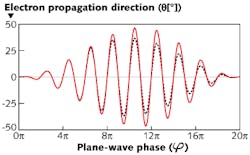Ultrahigh-intensity laser pulses could be measured with relativistic electrons
So-called ultrarelativistic laser pulses are those with peak intensities exceeding about 1020 W/cm2; intensities of such pulses—for example, the 1022 W/cm2 focused pulses produced by the 300 TW Hercules laser at the University of Michigan—are difficult to measure, because they far exceed the damage threshold of any conventional equipment. Researchers at the Max-Planck-Institut für Kernphysik (Heidelberg, Germany) have proposed an accurate peak-intensity measurement technique that relies on the interaction of the laser pulse with a beam of ultrarelativistic electrons. The highly directional electron beam creates a radiation spectrum via nonlinear Thomson scattering; this spectrum’s angular aperture is measured, determining the peak intensity.
The researchers calculated the details of this interaction (see plot of electron propagation direction θ as a function of plane-wave phase φ) both neglecting and including the effects of radiation reaction (black dotted curve and red solid curve, respectively), which is the action of the radiation emitted by the electron on the motion of the electron itself. The researchers note that the required electron energies (23 MeV in the calculation for a peak intensity of 1022 W/cm2) are well within reach of existing tabletop laser plasma accelerators. Contact Antonino Di Piazza at [email protected].

John Wallace | Senior Technical Editor (1998-2022)
John Wallace was with Laser Focus World for nearly 25 years, retiring in late June 2022. He obtained a bachelor's degree in mechanical engineering and physics at Rutgers University and a master's in optical engineering at the University of Rochester. Before becoming an editor, John worked as an engineer at RCA, Exxon, Eastman Kodak, and GCA Corporation.
